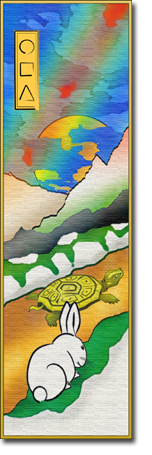On The Way: The Daily Zen Journal
The Eight Qualities of a Great Person – Part 1
Dogen (1200-1253)

All the various buddhas are extraordinary people. As there are eight realizations or qualities of which these exceptional people become aware, they have been referred to as the eight qualities of a great person.
Becoming aware of these dharmas becomes the cause for entering nirvana. On the evening he entered nirvana, this was the final teaching and testament of our first teacher, Shakyamuni Buddha.
1. Having Few Desires – Shoyoku
The first quality is having few desires. That is, not wildly chasing after the objects of one’s desires that have not yet been fulfilled is what is called having few desires.
The Buddha expounded, “Monks, here is something you need to be aware of. A person with many longings or cravings suffers proportionately greater, precisely because he or she seeks greater personal gain or other benefit. When one pursues few desires, there will be less suffering and fewer troubles.
“Personally, having few desires needs to be thoroughly studied and practiced. Moreover, not following those cravings engenders uncountable merits. A person with few cravings will never try to flatter nor ingratiate themselves with others. Nor would one of few desires be dragged around by the cravings of the five senses.
“One whose heart acts with few desires is always at peace and has few anxieties or misgivings. And regarding various matters, such a person feels no need for more; one always has more than enough. In a word, one with few desires is virtually in nirvana. This is what is called having few desires.”

2. Knowing One Has Enough – Chisoku
The second realization of a great person is knowing when one has enough. Limiting how much to accept of the dharmas, or things, one has already received is knowing one has enough.
The Buddha said, “Monks, if you wish to be rid of various pain and suffering, then you need to see clearly that you have enough.” This dharma of knowing when one has enough is precisely where you will find the greatest wealth, happiness, and peace of mind.
Despite having to sleep on the ground, a person who knows when to be satisfied will find comfort and be at ease. And to the contrary, a person who does not know what is sufficient will never be at ease and always be unsatisfied, even if they live in a gorgeous mansion. Despite having great wealth, a person not knowing when to be satisfied is, in fact, impoverished.

On the other hand, though a person may be materially poor, if they know what it means to have enough, then that person is truly rich. One who does not know having enough will always be pulled around by the five senses, only to be pitied by those who understand the meaning of having enough. This is what is referred to as knowing one has enough.
3. Appreciating Serenity/Quietude – Gyojakujo
The third quality is enjoying peace of mind. Avoiding noisy, bustling places that confuse the mind and living alone in a quiet, serene dwelling is called enjoying peace of mind.
The Buddha said, “Monks, if you wish to enjoy true tranquility, unaffected by the conditions around you, then clearly it is critical to live in a quiet place, apart from all the noise and clamor that surrounds you internally and externally.

“One of calm demeanor has always been highly respected by Indra and many other devas. For this reason, surely it is essential to put aside all personal affairs, find a quiet place to live, and ponder how to relieve the sources of suffering.
“If you take pleasure in being in a group, you will surely encounter the disharmony and suffering of the group. It is like a gathering of birds that nest in a large tree. Eventually, the tree will wither, and the limbs will come crashing down from the stress.
“Many people will sink into the depths of suffering due to the fetters and restrictions of society. It can be compared to an old elephant stuck in the mud and unable to extract itself from its depths. This is called living detached from both sensual desires and worldly affairs.”

4. Making Diligent Effort – Gonshojin
The fourth realization is one of perseverance. In all matters, continually striving to carry out deeds that are true and wholesome is making diligent effort. Sho means to be energetic and concentrated; not being sloppy or crude in one’s action. Jin means to deepen and improve one’s attitude without backsliding or giving up.
The Buddha said, “Monks, when you practice with diligence, there is nothing that is difficult. For that reason, it is critical that you persevere in your practice.
“By way of illustration, it is like water flowing constantly over a rock; even if it is just a trickle, eventually it will pierce the rock. Or, for example, if the mind of a practitioner is only sometimes energetic but at other times lets up, it can be compared to one who, when attempting to light a fire often stops twirling the stick before the fire catches hold; no matter how much one may want to have the fire, no fire will result if one continues in such a way. This is called persevering and making wholehearted effort.”
Dogen (1200-1253), Final Teaching
Excerpted from The Roots of Goodness – Eihei Dogen Zenji – Commentary by Kosho Uchiyama Roshi and translated by Daitsu Tom Wright 2025
 This was the last teaching of both the Buddha and Dogen before they died. For Dogen, it was part of his intention to rewrite all his work, and he had completed 11 chapters prior to this new piece. The impact of a great teacher’s final words resonates with depth. In the Buddha’s case, it’s as if he essentialized points he thought were most relevant for students and monks.
This was the last teaching of both the Buddha and Dogen before they died. For Dogen, it was part of his intention to rewrite all his work, and he had completed 11 chapters prior to this new piece. The impact of a great teacher’s final words resonates with depth. In the Buddha’s case, it’s as if he essentialized points he thought were most relevant for students and monks.
While all of them are just as attainable as they were hundreds of years ago, there are lines we moderns have to translate to the world we find ourselves in. Appreciating serenity and quietude becomes something that requires carving out space and time in our daily lives.
The Buddha said, “Monks, if you wish to enjoy true tranquility, unaffected by the conditions around you, then clearly it is critical to live in a quiet place, apart from all the noise and clamor that surrounds you internally and externally.”
Attaining a quiet place to live in our times, with the population density many times more than it was back then, amounts to an impossible dream for most of us. Now, that serenity comes from our own diligent practice and the ensuing slowing of the internal dialogue. That pause we inhabit between the thought streams brings a spaciousness and quiet not dependent on external circumstances.
Our meditation space becomes the quiet and serenity of a mountain hut; a morning walk can represent a calm mountain stroll. Arising before sunrise, when the outer world is literally more quiet allows us to experience the stillness before “all the noise and clamor.” There are many solutions to transform where and how we live into a place of practice.
Each one of these qualities provides a contemplation and a path to move forward into. Start with any one of them and see how deeply you can transform your daily life.

Making diligent effort with you,
Elana, Scribe for Daily Zen




